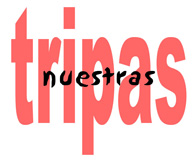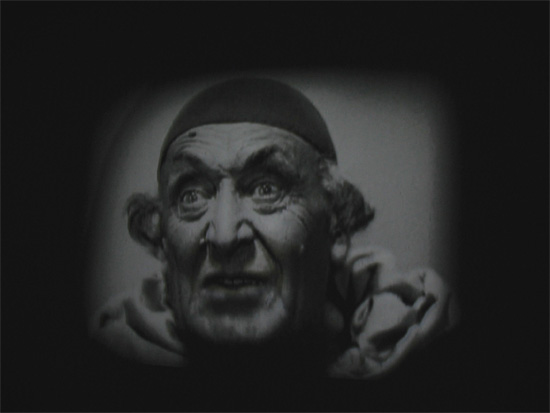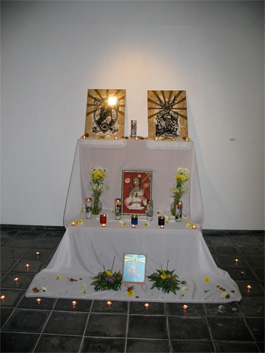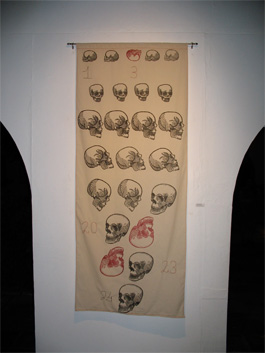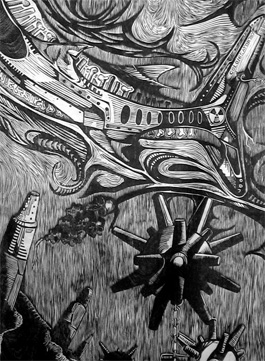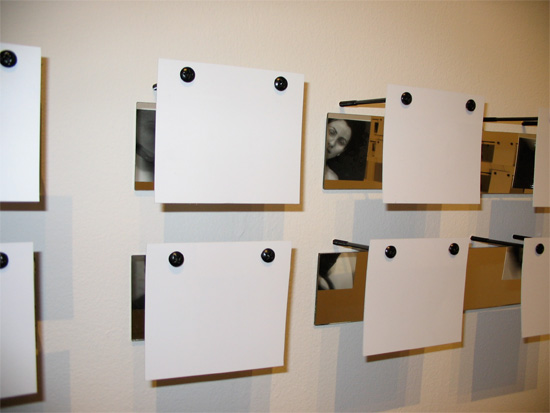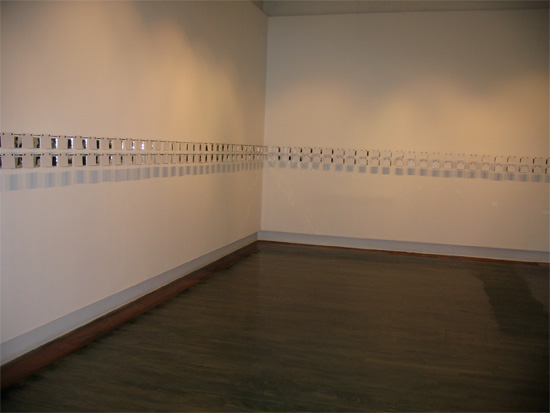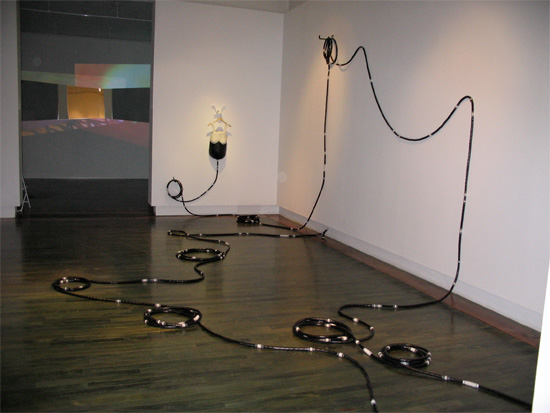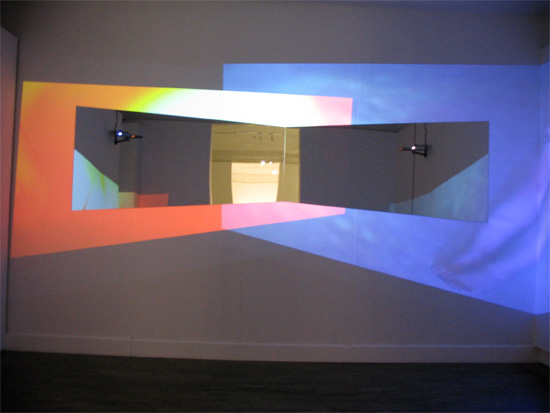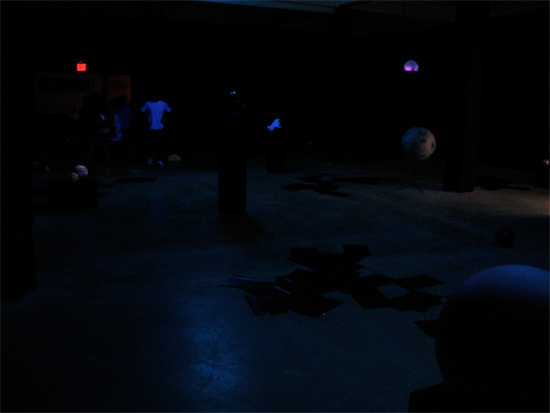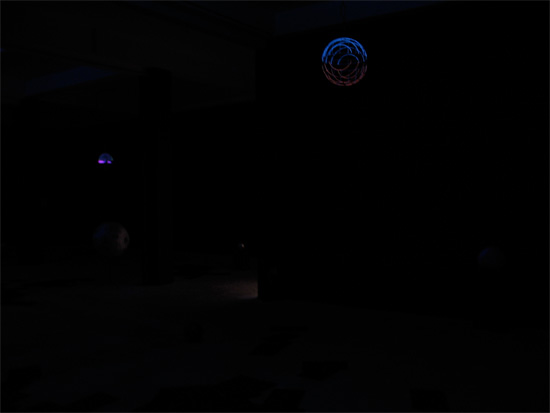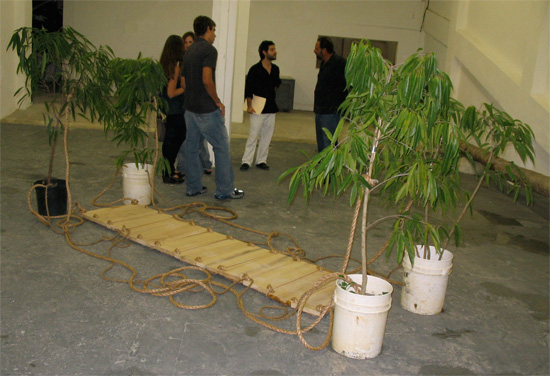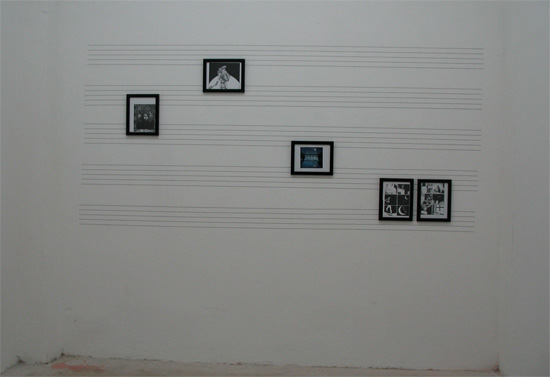|

Cock-and-Bull
As we were saying, it’s a hot time in the old town tonight. Every arts scribe on the avenue meets your gaze with the same haggard shrug. ¡Cabron! There is so effing much to see. Unless you labor in the offices of the island’s daily newspapers, where instead of going out you slouch behind your expanse of polished oak, furiously perusing the flood tide of badly-worded press releases and snarky, slang-encoded blogs, trying to get a clue. And then, with a heavy heart you pretend to write. The island’s biggest daily has lately been fairly bombarding us with verbiage about the art scene, but by and large it spends little time making critical distinctions or doing analysis of any kind. Whether the artist is laying out the arc of a hard-won, career-long trajectory or lobbing easy postgrad one-liners, readers get treated to the same three pages of earnest —or in the worst of cases, mock-literary—hooey. The island art scene shows no sign of losing its remarkable fizz any time soon, and someone at the paper should have the sense to take its true measure. Sounds like a job for an art critic. Coincidence, or happenstance? Perhaps there is a connection, as certain cackling artmobsters like to aver, between the unremitting japing and jibing, the sneering and generally bad behavior of a small crowd of disgruntled ne’er-do-wells in the community, individuals of small talent and vast cynicism, and the paper’s sudden keeness to get on the bus. Though maybe not; maybe, coincidentally, all those column inches of sodden arts coverage have “been in the works for some time,” to use a phrase. Be that as it may, a lot of Rotund readers are probably saying to themselves at this very juncture, “Get on with it, will you,” so we’ll leave it alone for the time being. Really. We’re not supposed to be naming names. Friends have warned us. But we can’t resist. When someone puts their butt in the air, what can you do? (The image above has nothing directly to do with any of this. It’s a still from Carl Theodor Dreyer’s 1928 silent film La Passion de Jeanne d’Arc, which comprises part of Javier Téllez's video-installation, La Passion de Jeanne D’Arc (Rozelle Hospital), 2004, now on view at Espacio 1414. This is just our way of reminding you to visit Julieta González's stellar new exhibition, Visiones de paraíso, ho ho. Avenida Fernández Juncos #1414, 787-725-3899.) So, what exactly is it we should have been attending to while instead we were vaguely fulminating? The smart people head over to Repuesto, Autogiro, Trance Líquido, or ¿Dónde Veo Arte? plus the various shock-and-awe sites dreamed up by Pedro Vélez or someone pretending to be him (visit the suspiciously Vélez-like Crying Lost Art to see how deftly the man can touch a nerve, if indeed it is he who is doing the touching, and his Box Score FGA, which our own ranting cannot begin to match for sheer volume and cantankerousness) when they want to know who’s the who and what’s the what.
We ourselves were late to the party when Perdóname, Madre, Soy Grabador [Forgive Me, Mother, I’m a Printmaker] got underway at the gallery at La Liga de Estudiantes de Arte in Viejo San Juan. This exhibition of recent prints by pretty serious, eager-beaver locals is another in an increasingly long line of artists’ self-generated exhibitions in more or less out-of-the-way places. These shows include not just things on the walls but spam-like gushers of web-borne publicity—so effective is this technique in creating the illusion of happeningness and youthitude that even the Pleistocene-thinking daily newspapers are taking notice—and groovy video aftermaths, also to be found in cyberspace. (Watch this document of Perdóname, Madre, courtesy of the masterminds at MSA-Xperimental Art.) So-called “catalogues,” pamphlets replete with copious though usually not very helpful reproductions of artworks, plus essays, often written by the featured guests themselves, have also become de rigueur. The overall effect is festive, at least on opening night, and often impressively put together, as is the case with this avid group of printmakers. Perdóname, Madre is modest is scope but promising in its ramifications. It evinces the can-do spirit that’s driving a dynamic segment of the contemporary art scene in San Juan and demonstrates the experimental proclivities of a new generation of artists who’ve chosen to ply the island’s venerable printmaking tradition. We stumbled in just as things were shutting down—the above-mentioned video shows artist-participant Abdiel Segarra printmaking up a storm at the height of the festivities —took note of a few familiars, such as Christopher Rivera, Elsa Meléndez, and Garvin Sierra, and drifted over to works by artists who were heretofore unknown to us, like the Carlos Raquel Rivera-like La batalla del COLONIZATOR 787 by José Ortiz and the entertaining, satirical, and shrineish Sin título (Altar a nuestra santa flagelación) by Omar Velázquez. An altar in a printmaking show? This, in the artists’ minds, is what constitutes progress. But give them a break. The print process abounds in this work, as the poor installation shot of the altar, below, shows. We had nothing to drink that night, we swear, though judging from the whack-a-do of our photos, you might well wonder. Herewith are the best of a bad lot. Perdónanos, Madre, no somos fotógrafos.
At the top of this section is a piquant detail of Velázquez’s altar, showing that playful, socially critical thinking still abides in the work of the new generation of printmakers. Above left is an annoyingly camera-flash enhanced shot of the whole shebang, and on the right is one of Christopher Rivera’s screenprints on canvas. Immediately above is a detail from Ortiz’s large print (a woodcut or linocut, we assume), which represented the tradition- minded side of the exhibition, both formally and thematically. We like the work quite a bit, fond as we are of the old-school Mexican printmakers who importantly influenced visiting Puerto Rican artists—and vice versa, of course—at mid-twentieth century. La Liga de Estudiantes de Arte de San Juan is located opposite one of Viejo San Juan’s landmarks, la Plaza de Quinto Centenario. The exhibition opened on July 19th and was supposed to run only until the August 15th, but who knows, you might luck out. Call La Liga at 787-722-4468 to see what’s on. Waltzing MatildaWe have more up-to-date, actually present exhibitions to talk about with you. Migdalia Barens-Vera opened her installation Parto at el Museo de Arte Contemporáneo a couple of weeks ago, Galería Comercial is showing new work by Adriana Lara and Michael Linares, and we’re awaiting decent images from el Museo de Arte de Puerto Rico so we can dig into the recent installation by Ada Bobonis in the museum’s project space, Espacios sensibles, the final exhibition at the museum curated by Marysol Nieves. For now, we’ll talk ever so briefly about Parto and Comercial’s 380°, and we encourage you to head over to the MAPR, MAC, and Galería Comercial websites for pertinent information about getting to and fro, hours, and so forth, and repeat what a dreadful pop song of long, long ago once yodeled to us for far too many weeks: Everything is beautiful, in its own way. We also suggest a looksee at Autogiro’s latest contrarian judgment, a skeptical look at Braulio Espinosa Castillo’s new installation at Galería Candela, Product? Inc. We’re amused as can be by Espinosa Castillo’s human-as-product doings, but as Autogiro’s Javier Martínez points out, the idea is as old a chestnut as the squirrels ever brought home. Judging from the lengthy—and abundantly, dismayingly uncritical—coverage of Espinosa Castillo’s work in El Nuevo Día, the project is not really as mirthful as you might expect; or at least the artist is damned earnest when he talks about it. Of course, we’re great believers that the artists’ intentions count only peripherally in our appreciation of what they produce, but we’re ever hopeful that on some level all of us are sharing the same cosmic jokes. And speaking of tuning in on the latest cyber-chatter, we like to razz Pedro Vélez for his reflexive misanthropy, and sometimes we want to grab him by the lapels he never wears and give his zoot suit a good wrinkling. Pedro! we want to shout. His judgment really went south concerning END’s long story on Espinosa Castillo, and why bother tussling with the crown prince or even the court jester of fotoperiodístas for endless paragraphs? But his latest posting at Box Score FGA offers up images of a series of carteles regarding the murder—execution is more like it—of an unarmed citizen by Puerto Rican police. The carteles say in part, quoting the assailant, “Yo soy la policia de Puerto Rico.” As Vélez headlines his post, “it’s a symptom of the corruption of the country.”
Migdalia Barens-Vera got our attention at the IX Bienal Internacional de Cuenca with a multimedia four-screen video installation which was only the tail end of a rather elaborate performance. If performance is the correct word. One thing we didn’t dwell on in our Edcuadorian report (beginning here, in case you just dropped in) was how much we liked the way the biennial spread itself all over the Andean colonial city. This arrangement struck some of the attending artists as a pain in the nalgas, being difficult to navigate on foot, but not us. Visiting the scattered venues gave us an opportunity to see the architectural glories of Cuenca—the city has undergone periodic outbursts of architectural renovation, including a moment at the end of the nineteenth century and the beginning of the twentieth which gave it a lot of still-existing Victorian façades—and it provided Barens-Vera with the conceit for her biennial work: traipsing about the town pushing a lidded Plexiglas cube on wheels, into which she tossed clothing, footwear, plants, miscellaneous finds, and, at night, herself. The cube was shopping cart, sight-seeing bus, motel, and the engine for her art, all of it video-taped as she wandered. We liked the installation as much for the light which bathed the darkened space in Cuenca’s Centro de Alto Rendimiento as for whatever it was that impelled the artist, in ragamuffin guise, around the city. The role she played seemed hermetic and self-consciously waifish, at least in the very brief segment of the video that we saw, though her contraption fit well into the vehicle-of-necessity aesthetic that is all the rage now and belongs to a tradition stretching back, in our experience, to the early 1990s shopping cart-living quarters of Kristof Wodiczko. The video’s bright, proplusive rhythms lent the cube a reliquary air, which was perhaps the point, and in that we liked it as much as a lot of what we saw in Ecuador.
The artist’s new installation, Parto, at Museo de Arte Contemporáneo shows the same attention to what you might call craft. Again, it’s a somewhat elaborate scheme neatly put together, consisting in part of small photographs, perhaps of the artist herself; almost, but not quite, hidden from view by dint of the fact that they’re turned to the wall and line the room in two tight rows at eye level. Each photograph faces a small mirror mounted on the wall, and the effect is an endless procession of partial glimpses: contorted faces, limbs, amorphous cloud-like forms. In the next room a black hose loops across the floor and around hooks on the walls, starting, or perhaps ending, at a body device resembling a very pregnant woman’s swimsuit, which hangs on a wooden hanger attached to the wall. The arrangement is umbilical, industrial, and weirdly fashion-conscious all at the same time.
Beyond this room is what we consider the exhibition’s main attraction, a video and light projection with both a confounding narrative involving a pair of legs and a swimming pool, and the much more accessible lightshow effect of colorful geometric abstractions playing about two trapezoidal mirrors side-by-side on the back wall. Flash flash, it was a relief for us, strangers for the most part to the bodily mysteries of pregnancy, not to have to think too much about what all the tubing, fluids, and apparent agony means.
You may be more inclined, but in any event we encourage you to take a look for yourself. See what something well-made looks like in a world where conceptual highjinks seem to count more than the rigors of form. Avenida Ponce de León at R.H. Todd is the place, and we’ve never had trouble parking on the lawn. Call 787-977-4030 or visit the website for hours and other information. We do know that Parto lasts only until August 26. There is also a new installation of the permanent collection, Restos, which we have yet to visit, done up by curator Brenda Torres Figueroa and so certainly worth a visit.
While you’re in the neighborhood, head on down to Fernández Juncos #1600—it’s the very pink, graffiti-splashed building on the corner—for a look at the latest from our pals at Galería Comerical. The main space has a kind of black-light starry-night show titled 380° from Adriana Lara. We found the installation to have a low-rent Olafur Eliasson feel on our first visit, which is the work’s blessing and its curse. We kept bumping into rough-hewn heavenly bodies that dangle or sit about on pedestals, and the floor is littered with dark sheets of paper or plastic with star-like scatterings of points of light. It’s supposed to be cosmic, we’re guessing, although one table features some clunky electronic gear with dim backlighting, looking like oversized Palm Pilots from 1993, barely hanging on. The raggedy, low-tech presentation says, like a lot of what’s going on in a certain segment of artworld society, “Screw the object,” and who can blame the artist since it’s a lot closer to handmade than Eliasson’s cool, precision, failsafe machinery. It’s more fun in a backyard-theater sort of way, and there are moments, such as the ceiling-borne sphere of metallic, club-life blues and oranges, that are lighter than air.
Perhaps it’s hearing the breathless description from Tito of Michael Linares’s Wait till it grows (Hanging bridge) that left us nonplused after seeing the work for the first time. Or maybe it’s that water-stained concrete floor. We like Linares’s idea, but we find that his bare-bones sculptural propositions have more impact when surrounded by drawings and paintings, as they were at the artist’s last one-person show at the gallery.
More to our immediate liking is the project space, always a gas as long as the Mexican collective Perros Negros abides there. In our mad dash during opening night, we could only determine that the space has a three-part video and some drawings from a comic novel, a copy of which is on the room’s endtable. We noticed that Elena Poniatowska, the grande dame of Mexican letters, wrote the introduction, and although we didn’t catch the writer-artist’s name at the time, that was good enough for us. From the top of this section, the images show two installation shots of Adriana Lara’s 380°, Michael Linares’s Wait till it grows (Hanging bridge), and below that, a detail of Galería Sentimental by Perros Negros. We’ll soon have those photographs of Ada Bobonis’s new work, no doubt, and we can’t wait because, as we told you once or twice already, we really, really want to talk about it. Meantime, take a walk on the wild side, below. Rotund rolls at last. |
